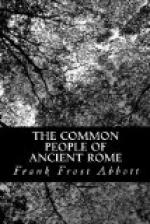This road and the other great highways which were constructed in Italy brought not only all the colonies, but all parts of the peninsula, into easy communication with the capital. The earliest of them was built to Capua, as we know, by the great censor Appius Claudius, in 312 B.C., and when one looks at a map of Italy at the close of the third century before our era, and sees the central and southern parts of the peninsula dotted with colonies, the Appian Way running from Rome south-east to Brundisium, the Popillian Way to Rhegium, the Flaminian Way north-east to Ariminum, with an extension to Cremona, with the Cassian and Aurelian ways along the western coast, the rapidity and the completeness with which the Latin language overspread Italy ceases to be a mystery. A map of Spain or of France under the Empire, with its network of roads, is equally illuminating.
The missionaries who carried Roman law, Roman dress, Roman ideas, and the Latin language first through central, southern, and northern Italy, and then to the East and the West, were the colonist, the merchant, the soldier, and the federal official. The central government exempted the Roman citizen who settled in a provincial town from the local taxes. As these were very heavy, his advantage over the native was correspondingly great, and in almost all the large towns in the Empire we find evidence of the existence of large guilds of Roman traders, tax-collectors, bankers, and land-owners.[5] When Trajan in his romantic eastern campaign had penetrated to Ctesiphon, the capital of Parthia, he found Roman merchants already settled there. Besides the merchants and capitalists who were engaged in business on their own account in the provinces, there were thousands of agents for the great Roman corporations scattered through the Empire. Rome was the money centre of the world, and the great stock companies organized to lend money, construct public works, collect taxes, and engage in the shipping trade had their central offices in the capital whence they sent out their representatives to all parts of the world.
The soldier played as important a part as the merchant in extending the use of Latin. Tacitus tells us that in the reign of Augustus there were twenty-five legions stationed in the provinces. If we allow 6,000 men to a legion, we should have a total of 150,000 Roman soldiers scattered through the provinces. To these must be added the auxiliary troops which were made up of natives who, at the close of their term of service, were probably able to speak Latin, and when they settled among their own people again, would carry a knowledge of it into ever-widening circles. We have no exact knowledge of the number of the auxiliary troops, but they probably came to be as numerous as the legionaries.[6] Soldiers stationed on the frontiers frequently married native women at the end of their term of service, passed the rest of their lives in the provinces, and their children learned Latin.




